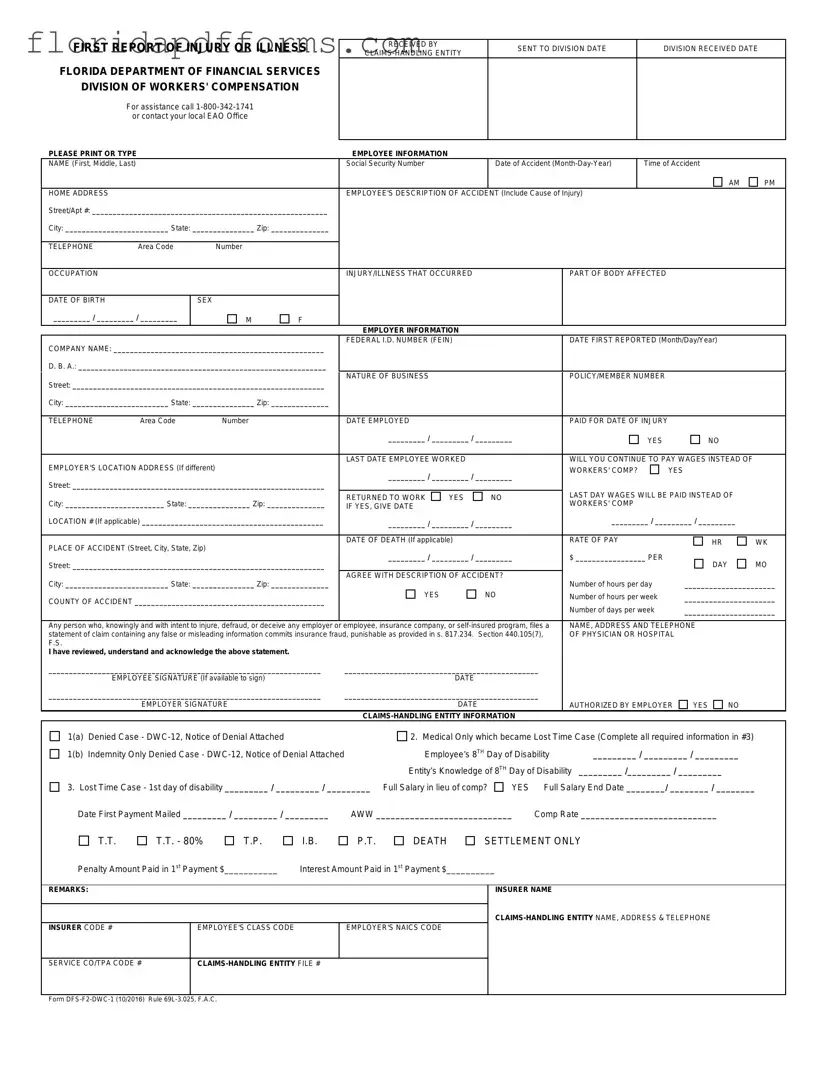The OSHA 300 Log is a document used by employers to record work-related injuries and illnesses. Similar to the First Report of Injury Florida form, it captures essential details about the incident, including the date, type of injury, and affected body parts. The OSHA 300 Log serves as a summary of all reported cases, making it easier for employers to track incidents over time. Both documents aim to ensure workplace safety by documenting injuries and promoting transparency in reporting.
The Employee Incident Report is another document that resembles the First Report of Injury Florida form. This report is typically filled out by employees immediately after an accident occurs. It includes information about the employee, the nature of the incident, and witness accounts. Like the First Report of Injury, the Employee Incident Report focuses on gathering accurate details to facilitate investigations and claims processing, ensuring that all relevant facts are documented promptly.
The Workers' Compensation Claim Form is directly related to the First Report of Injury Florida form. This form is submitted to initiate a claim for workers' compensation benefits. It requires similar information, such as the employee's details, accident description, and employer information. Both documents are essential for processing claims and ensuring that employees receive the benefits they are entitled to after a work-related injury.
The Accident Investigation Report is another document that shares similarities with the First Report of Injury Florida form. This report is created to analyze the causes of an accident and recommend safety improvements. It includes details about the incident, witnesses, and the conditions at the time of the accident. While the First Report focuses on reporting the injury, the Accident Investigation Report aims to prevent future occurrences by identifying hazards and implementing corrective actions.
The State Workers' Compensation Board Form is also comparable to the First Report of Injury Florida form. This form is used to report injuries to the state’s workers' compensation board. It collects similar information about the employee, the accident, and the employer. Both documents help ensure compliance with state regulations and facilitate the processing of claims for injured workers.
The Return to Work form is another relevant document. It is used when an employee is ready to resume work after an injury. This form often references the details provided in the First Report of Injury, ensuring that the employer is aware of any restrictions or accommodations needed. Both documents play a crucial role in managing an employee's recovery and reintegration into the workplace.
The Medical Authorization Form is similar in that it allows the employer to obtain medical records related to an employee's injury. This form is crucial for verifying the details of the injury and ensuring that the appropriate care is being provided. Like the First Report of Injury, it emphasizes the importance of accurate and timely information to support claims and treatment plans.
The Claim for Compensation form, often required in various states, is also akin to the First Report of Injury Florida form. This document is used to formally request compensation for lost wages and medical expenses resulting from a work-related injury. Both forms require detailed information about the incident and the employee’s condition, facilitating the claims process and ensuring that employees receive the support they need.
The Final Report of Injury is another document that parallels the First Report of Injury Florida form. This report is typically completed at the conclusion of a claim, summarizing the injury, treatment, and any compensation awarded. While the First Report initiates the claims process, the Final Report provides a comprehensive overview of the entire case, ensuring that all relevant details are documented and accessible for future reference.
Lastly, the Employer's Report of Injury is similar to the First Report of Injury Florida form. This document is filled out by the employer to report an employee's injury to the insurance company. It includes information about the employee, the accident, and any actions taken post-incident. Both reports are vital for ensuring that all parties are informed and that the claims process can move forward efficiently.

